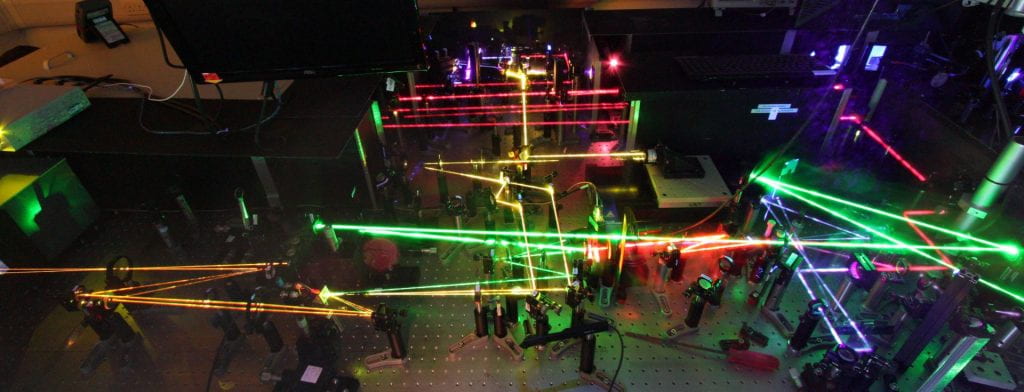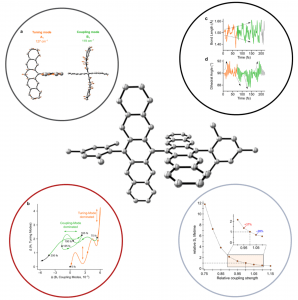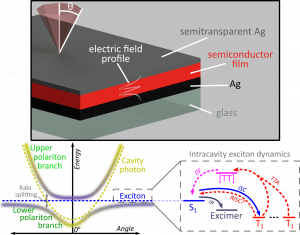Skip to content
 We use a versatile toolbox of ultrafast optical spectroscopy techniques to track, understand and manipulate the functional properties of complex organic materials. Projects range from fundamental investigation of light-matter interactions to optimising material processing for high-efficiency light-emitting devices, falling under one or two of these broad streams:
We use a versatile toolbox of ultrafast optical spectroscopy techniques to track, understand and manipulate the functional properties of complex organic materials. Projects range from fundamental investigation of light-matter interactions to optimising material processing for high-efficiency light-emitting devices, falling under one or two of these broad streams:
1 – Molecular movies
Time-resolved spectroscopy lets us record real-time ‘movies’ of energy relaxation processes, capturing events that take as little as 50 femtoseconds. We can observe how the properties of materials change as the electronic states relax. Processes on these very fast timescales are among the most challenging to capture and describe, as they occur in regimes well beyond the Born-Oppenheimer approximation where nuclear vibrations couple to and drive electronic dynamics. Using the latest vibrational spectroscopy techniques, we can directly monitor how molecules move as they undergo important light-induced processes and begin to build new fundamental understanding of reactions from photoprotection to biological light harvesting.
 Highlight: In our search for a ‘magic mode’ driving ultrafast photophysics, we turned to a pentacene dimer capable of singlet fission. Combining our ultrafast vibrational measurements with cutting-edge real-time quantum dynamics simulations, we could directly identify the nuclear motions recorded in our data. This stunning agreement between experiment and theory let us use the simulations to reconstruct the atomically detailed molecular movie of the singlet fission reaction, providing unprecedented insight into the dynamics following photoexcitation. Schnedermann, Alvertis, Wende, Lukman, Feng, Schröder, Turban, Wu, Hine, Greenham, Chin, Rao, Kukura & Musser. ‘A molecular movie of ultrafast singlet fission.’ Nature Communications 2019
Highlight: In our search for a ‘magic mode’ driving ultrafast photophysics, we turned to a pentacene dimer capable of singlet fission. Combining our ultrafast vibrational measurements with cutting-edge real-time quantum dynamics simulations, we could directly identify the nuclear motions recorded in our data. This stunning agreement between experiment and theory let us use the simulations to reconstruct the atomically detailed molecular movie of the singlet fission reaction, providing unprecedented insight into the dynamics following photoexcitation. Schnedermann, Alvertis, Wende, Lukman, Feng, Schröder, Turban, Wu, Hine, Greenham, Chin, Rao, Kukura & Musser. ‘A molecular movie of ultrafast singlet fission.’ Nature Communications 2019
2 – Triplet dynamics
Most applications of organic optoelectronic materials are concerned with ‘bright’ singlet states, meaning they can absorb and emit light. However, in functional devices the majority species are ‘dark’ triplet states. These can be a major loss pathway, especially in electrically driven devices where they are formed in 3:1 ratio over the desirable singlets. Processes that drive the conversion between singlet and triplet manifolds are at the forefront of organic materials research, whether to find ways to get rid of the triplets or to turn their energy into something useful. In reverse intersystem crossing, a low-energy triplet can repopulate the useful singlet manifold through activation over a thermal barrier, allowing the harvesting of these ‘dark’ species in devices. In singlet fission, a photogenerated singlet state can spontaneously separate into two distinct triplets, resulting in two excited states from a single absorbed photon. If we can better understand how this process works and learn how to efficiently harvest these triplets, this 2-for-1 deal promises to revolutionise solar cells. We explore the often-murky mechanisms of these processes and work together with synthetic chemists to extract structure-property relationships that will lead to better molecules, more efficient devices and new concepts in photocatalysis.
 Pre-C&CB highlight: Together with my long-standing collaborator Dr. Jenny Clark, we lay out the theoretical and experimental basis for understanding the all-important triplet-pair states which gate the transition between singlet and triplet manifolds. We cover some of the essential challenges facing the singlet fission field and highlight areas where standard data interpretations seem contradictory. Essential reading for anyone interested in singlet fission? You be the judge. Musser & Clark. ‘Triplet-pair states in organic semiconductors.’ Annual Review of Physical Chemistry 2019
Pre-C&CB highlight: Together with my long-standing collaborator Dr. Jenny Clark, we lay out the theoretical and experimental basis for understanding the all-important triplet-pair states which gate the transition between singlet and triplet manifolds. We cover some of the essential challenges facing the singlet fission field and highlight areas where standard data interpretations seem contradictory. Essential reading for anyone interested in singlet fission? You be the judge. Musser & Clark. ‘Triplet-pair states in organic semiconductors.’ Annual Review of Physical Chemistry 2019
3 – Polariton-enhanced materials
When two mirrors are placed very close together – on the order of the wavelength of light – they form an optical cavity that traps photons of a particular wavelength. If we put a strong absorber inside (dyes, organic semiconductors, even living bacteria!) it can interact with the confined light modes, forming entirely new states with a mixture of light and matter properties. These ‘polariton’ states can radically restructure the potential energy landscape, and applications have been suggested from catalysis to solar cells. We have discovered that polariton formation creates new and entirely unexpected channels for molecules to emit light, an effect of their complex electronic structure. We now seek to understand how this behaviour can be controlled, and in what other ways we can enhance functional material properties with light.
 Highlight: In organic materials, we describe high-spin states like triplets as ‘dark’ for a very good reason – they typically don’t interact with light. One might thus expect that they would have nothing to do with the light-matter interactions that give rise to polaritons. Very surprisingly, we find in this study that polariton formation gives these dark states an unprecedented way to emit light. This effect shouldn’t be allowed in the standard picture of polaritons, but we can explain it by embracing the rich, messy complexity of organic semiconductors’ electronic structure. This effect may lead directly to more efficient OLEDs, and it also suggests that polaritons can be used in new and unexpected ways to manipulate molecules’ properties. Polak, Jayaprakash, Lyons, Martinez-Martinez, Leventis, Fallon, Coulthard, Bossanyi, Georgiou, Petty II, Anthony, Bronstein, Yuen-Zhou, Tartakovskii, Clark & Musser. ‘Manipulating molecules with strong coupling: harvesting triplet excitons in organic exciton microcavities’ Chemical Science 2019, HOT Article and Pick of the Week.
Highlight: In organic materials, we describe high-spin states like triplets as ‘dark’ for a very good reason – they typically don’t interact with light. One might thus expect that they would have nothing to do with the light-matter interactions that give rise to polaritons. Very surprisingly, we find in this study that polariton formation gives these dark states an unprecedented way to emit light. This effect shouldn’t be allowed in the standard picture of polaritons, but we can explain it by embracing the rich, messy complexity of organic semiconductors’ electronic structure. This effect may lead directly to more efficient OLEDs, and it also suggests that polaritons can be used in new and unexpected ways to manipulate molecules’ properties. Polak, Jayaprakash, Lyons, Martinez-Martinez, Leventis, Fallon, Coulthard, Bossanyi, Georgiou, Petty II, Anthony, Bronstein, Yuen-Zhou, Tartakovskii, Clark & Musser. ‘Manipulating molecules with strong coupling: harvesting triplet excitons in organic exciton microcavities’ Chemical Science 2019, HOT Article and Pick of the Week.
4 – Room-temperature quantum information
Polaritons can form macroscopic Bose-Einstein condensates, with applications from low-threshold lasers to quantum computing. Using organic materials, such condensates can even be attained at room temperature, but very few such materials have been reported and they have little in common. We seek to understand the materials properties that enable polariton condensation, building towards room-temperature and electrically injected quantum devices.
 We use a versatile toolbox of ultrafast optical spectroscopy techniques to track, understand and manipulate the functional properties of complex organic materials. Projects range from fundamental investigation of light-matter interactions to optimising material processing for high-efficiency light-emitting devices, falling under one or two of these broad streams:
We use a versatile toolbox of ultrafast optical spectroscopy techniques to track, understand and manipulate the functional properties of complex organic materials. Projects range from fundamental investigation of light-matter interactions to optimising material processing for high-efficiency light-emitting devices, falling under one or two of these broad streams: Highlight: In our search for a ‘magic mode’ driving ultrafast photophysics, we turned to a pentacene dimer capable of singlet fission. Combining our ultrafast vibrational measurements with cutting-edge real-time quantum dynamics simulations, we could directly identify the nuclear motions recorded in our data. This stunning agreement between experiment and theory let us use the simulations to reconstruct the atomically detailed molecular movie of the singlet fission reaction, providing unprecedented insight into the dynamics following photoexcitation. Schnedermann, Alvertis, Wende, Lukman, Feng, Schröder, Turban, Wu, Hine, Greenham, Chin, Rao, Kukura & Musser. ‘A molecular movie of ultrafast singlet fission.’ Nature Communications 2019
Highlight: In our search for a ‘magic mode’ driving ultrafast photophysics, we turned to a pentacene dimer capable of singlet fission. Combining our ultrafast vibrational measurements with cutting-edge real-time quantum dynamics simulations, we could directly identify the nuclear motions recorded in our data. This stunning agreement between experiment and theory let us use the simulations to reconstruct the atomically detailed molecular movie of the singlet fission reaction, providing unprecedented insight into the dynamics following photoexcitation. Schnedermann, Alvertis, Wende, Lukman, Feng, Schröder, Turban, Wu, Hine, Greenham, Chin, Rao, Kukura & Musser. ‘A molecular movie of ultrafast singlet fission.’ Nature Communications 2019 Pre-C&CB highlight: Together with my long-standing collaborator Dr. Jenny Clark, we lay out the theoretical and experimental basis for understanding the all-important triplet-pair states which gate the transition between singlet and triplet manifolds. We cover some of the essential challenges facing the singlet fission field and highlight areas where standard data interpretations seem contradictory. Essential reading for anyone interested in singlet fission? You be the judge. Musser & Clark. ‘Triplet-pair states in organic semiconductors.’ Annual Review of Physical Chemistry 2019
Pre-C&CB highlight: Together with my long-standing collaborator Dr. Jenny Clark, we lay out the theoretical and experimental basis for understanding the all-important triplet-pair states which gate the transition between singlet and triplet manifolds. We cover some of the essential challenges facing the singlet fission field and highlight areas where standard data interpretations seem contradictory. Essential reading for anyone interested in singlet fission? You be the judge. Musser & Clark. ‘Triplet-pair states in organic semiconductors.’ Annual Review of Physical Chemistry 2019 Highlight: In organic materials, we describe high-spin states like triplets as ‘dark’ for a very good reason – they typically don’t interact with light. One might thus expect that they would have nothing to do with the light-matter interactions that give rise to polaritons. Very surprisingly, we find in this study that polariton formation gives these dark states an unprecedented way to emit light. This effect shouldn’t be allowed in the standard picture of polaritons, but we can explain it by embracing the rich, messy complexity of organic semiconductors’ electronic structure. This effect may lead directly to more efficient OLEDs, and it also suggests that polaritons can be used in new and unexpected ways to manipulate molecules’ properties. Polak, Jayaprakash, Lyons, Martinez-Martinez, Leventis, Fallon, Coulthard, Bossanyi, Georgiou, Petty II, Anthony, Bronstein, Yuen-Zhou, Tartakovskii, Clark & Musser. ‘Manipulating molecules with strong coupling: harvesting triplet excitons in organic exciton microcavities’ Chemical Science 2019, HOT Article and Pick of the Week.
Highlight: In organic materials, we describe high-spin states like triplets as ‘dark’ for a very good reason – they typically don’t interact with light. One might thus expect that they would have nothing to do with the light-matter interactions that give rise to polaritons. Very surprisingly, we find in this study that polariton formation gives these dark states an unprecedented way to emit light. This effect shouldn’t be allowed in the standard picture of polaritons, but we can explain it by embracing the rich, messy complexity of organic semiconductors’ electronic structure. This effect may lead directly to more efficient OLEDs, and it also suggests that polaritons can be used in new and unexpected ways to manipulate molecules’ properties. Polak, Jayaprakash, Lyons, Martinez-Martinez, Leventis, Fallon, Coulthard, Bossanyi, Georgiou, Petty II, Anthony, Bronstein, Yuen-Zhou, Tartakovskii, Clark & Musser. ‘Manipulating molecules with strong coupling: harvesting triplet excitons in organic exciton microcavities’ Chemical Science 2019, HOT Article and Pick of the Week.